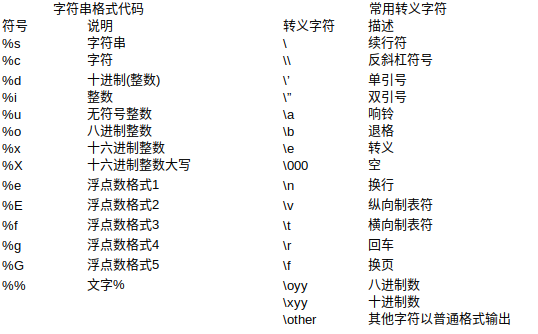格式化输出(%用法和fomat用法)
一:%用法
1、整数输出
%o —— oct 八进制
%d —— dec 十进制
%x —— hex 十六进制
print('%o' % 20) #
print('%d' % 20) #
print('%x' % 20) #
2、浮点数输出
%f ——保留小数点后面六位有效数字
%.3f,保留3位小数位
%e ——保留小数点后面六位有效数字,指数形式输出
%.3e,保留3位小数位,使用科学计数法
%g ——在保证六位有效数字的前提下,使用小数方式,否则使用科学计数法
%.3g,保留3位有效数字,使用小数或科学计数法
print('%f' % 1.11) # 默认保留6位小数 1.110000
print('%.1f' % 1.11) # 取1位小数 1.1
print('%e' % 1.11) # 默认6位小数,用科学计数法 1.110000e+00
print('%.3e' % 1.11) # 取3位小数,用科学计数法 1.110e+00
print('%g' % 1111.1111) # 默认6位有效数字 1111.11
print('%.7g' % 1111.1111) # 取7位有效数字 1111.111
print('%.2g' % 1111.1111) # 取2位有效数字,自动转换为科学计数法 1.1e+03
3、字符串输出
%s
%10s——右对齐,占位符10位
%-10s——左对齐,占位符10位
%.2s——截取2位字符串
%10.2s——10位占位符,截取两位字符串
print('%s' % 'hello world') # 字符串输出 hello world
print('%20s' % 'hello world') # 右对齐,取20位,不够则补位 hello world
print('%-20s' % 'hello world') # 左对齐,取20位,不够则补位 hello world
print('%.2s' % 'hello world') # 取2位 he
print('%10.2s' % 'hello world') # 右对齐,取2位 he
print('%-10.2s' % 'hello world') # 左对齐,取2位 he
4、其他

二:format用法
相对基本格式化输出采用‘%’的方法,format()功能更强大,该函数把字符串当成一个模板,通过传入的参数进行格式化,并且使用大括号‘{}’作为特殊字符代替‘%’
1、位置匹配
(1)不带编号,即“{}”
(2)带数字编号,可调换顺序,即“{1}”、“{2}”
(3)带关键字,即“{a}”、“{tom}”
print('{} {}'.format('hello','world')) # 不带字段 hello world
print('{0} {1}'.format('hello','world')) # 带数字编号 hello world
print('{0} {1} {0}'.format('hello','world')) # 打乱顺序 hello world hello
print('{1} {1} {0}'.format('hello','world')) # world world hello
print('{a} {tom} {a}'.format(tom='hello',a='world')) # 带关键字 world hello world
# 通过位置匹配
print('{0}, {1}, {2}'.format('a', 'b', 'c')) # a, b, c
print('{}, {}, {}'.format('a', 'b', 'c')) # 3.1+版本支持 a, b, c
print('{2}, {1}, {0}'.format('a', 'b', 'c')) # c, b, a
print('{2}, {1}, {0}'.format(*'abc')) # 可打乱顺序 c, b, a
print('{0}{1}{0}'.format('abra', 'cad')) # 可重复 abracadabra
# 通过类的属性匹配
class Point:
def __init__(self, x, y):
self.x, self.y = x, y
def __str__(self):
return 'Point({self.x}, {self.y})'.format(self=self)
print(str(Point(4, 2))) # Point(4, 2)
# 通过下标或者key匹配参数
coord = (3, 5)
print('X: {0[0]}; Y: {0[1]}'.format(coord)) # X: 3; Y: 5
a = {'a': 'test_a', 'b': 'test_b'}
print('X: {0[a]}; Y: {0[b]}'.format(a)) # X: test_a; Y: test_b
2、格式转换
'b' - 二进制。将数字以2为基数进行输出。
'c' - 字符。在打印之前将整数转换成对应的Unicode字符串。
'd' - 十进制整数。将数字以10为基数进行输出。
'o' - 八进制。将数字以8为基数进行输出。
'x' - 十六进制。将数字以16为基数进行输出,9以上的位数用小写字母。
'e' - 幂符号。用科学计数法打印数字。用'e'表示幂。
'g' - 一般格式。将数值以fixed-point格式输出。当数值特别大的时候,用幂形式打印。
'n' - 数字。当值为整数时和'd'相同,值为浮点数时和'g'相同。不同的是它会根据区域设置插入数字分隔符。
'%' - 百分数。将数值乘以100然后以fixed-point('f')格式打印,值后面会有一个百分号。
print('{0:b}'.format(3)) #
print('{:c}'.format(20)) #
print('{:d}'.format(20)) #
print('{:o}'.format(20)) #
print('{:x}'.format(20)) #
print('{:e}'.format(20)) # 2.000000e+01
print('{:g}'.format(20.1)) # 20.1
print('{:f}'.format(20)) # 20.000000
print('{:n}'.format(20)) #
print('{:%}'.format(20)) # 2000.000000%
3、format变形用法
# f"xxxx"
# 可在字符串前加f以达到格式化的目的,在{}里加入对象,此为format的另一种形式: a = "hello"
b = "world"
print(f"{a} {b}") name = 'jack'
age = 18
sex = 'man'
job = "IT"
salary = 9999.99 print(f'my name is {name.capitalize()}.') # my name is Jack.
print(f'I am {age:*^10} years old.') # I am ****18**** years old.
print(f'I am a {sex}') # I am a man
print(f'My salary is {salary:10.3f}') # My salary is 9999.990
格式化输出(%用法和fomat用法)的更多相关文章
- python基础_格式化输出(%用法和format用法)(转载)
python基础_格式化输出(%用法和format用法) 目录 %用法 format用法 %用法 1.整数的输出 %o -- oct 八进制%d -- dec 十进制%x -- hex 十六进制 &g ...
- python基础_格式化输出(%用法和format用法)
目录 %用法 format用法 %用法 1.整数的输出 %o —— oct 八进制%d —— dec 十进制%x —— hex 十六进制 1 >>> print('%o' % 2 ...
- 【Python笔记】1、格式化输出(%用法和format用法)
转自:https://www.cnblogs.com/fat39/p/7159881.html 一.格式化输出1.整数的输出%o —— oct 八进制%d —— dec 十进制%x —— hex 十六 ...
- 自学Python1.8-python input/print用法 格式化输出
自学Python之路 自学Python1.8-python input/print用法 格式化输出 1.input函数 Python3.x 中 input() 函数接受一个标准输入数据,返回为 str ...
- golang格式化输出-fmt包用法详解
golang格式化输出-fmt包用法详解 注意:我在这里给出golang查询关于包的使用的地址:https://godoc.org 声明: 此片文章并非原创,大多数内容都是来自:https:// ...
- Python格式化输出——format用法示例
format OR % 提到Python中的格式化输出方法,一般来说有以下两种方式: print('hello %s' % 'world') # hello world print('hello {} ...
- python格式化输出之format用法
format用法 相对基本格式化输出采用‘%’的方法,format()功能更强大,该函数把字符串当成一个模板,通过传入的参数进行格式化,并且使用大括号‘{}’作为特殊字符代替‘%’ 使用方法由两种:b ...
- python格式化输出(% format用法)
%基本用法: 十进制输出:print('%d' % 6) 6也可以换成其它的数字变量 八进制输出:print('%o' % 6) 6也可以换成其它的数字变量 字符串输出:print('%s' ...
- Python print函数用法,print 格式化输出
原文地址:http://blog.csdn.net/zanfeng/article/details/52164124 使用print输出各型的 字符串 整数 浮点数 出度及精度控制 strHello ...
随机推荐
- 封装:Windows系统文件图标
原文:封装:Windows系统文件图标 用途:用于获取文件系统默认图标 using System; using System.Collections.Generic; using System.Dra ...
- Linux下快速安装Python3和pip
如果本机安装了python2,尽量不要管他,使用python3运行python脚本就好,因为可能有程序依赖目前的python2环境, 比如yum!!!!! 不要动现有的python2环境! 一.安装p ...
- Vert.x Web
https://vertx.io/docs/vertx-web/java/ Vert.x-Web是一组用于使用Vert.x构建Web应用程序的构建块.将其视为瑞士军刀,用于构建现代,可扩展的网络应用程 ...
- js/jquery键盘事件及keycode大全
js/jquery的键盘事件分为keypress.keydown和keyup事件 一.键盘事件 1.keydown()事件当按钮被按下时,发生 keydown 事件. 2.keypress()事件ke ...
- Mybatis源码解析(三) —— Mapper代理类的生成
Mybatis源码解析(三) -- Mapper代理类的生成 在本系列第一篇文章已经讲述过在Mybatis-Spring项目中,是通过 MapperFactoryBean 的 getObject( ...
- spark存储管理之磁盘存储--DiskStore
DiskStore 接着上一篇,本篇,我们分析一下实现磁盘存储的功能类DiskStore,这个类相对简单.在正式展开之前,我觉得有必要大概分析一下BlockManager的背景,或者说它的运行环境,运 ...
- 下载安装Tomcat教程
注:由于我的笔记不知怎么滴不能复制粘贴我就直接贴图了
- 025:为什么需要将Logger对象声明为private static final类型的
本文阅读时间大约4分钟. 参考答案 就这个问题而言,我总结了三个原因: 设置为private是为了防止其他类使用当前类的日志对象: 设置为static是为了让每个类中的日志对象只生成一份,日志对象是属 ...
- NN入门
参考资料:https://blog.csdn.net/kwame211/article/details/77337166, 仅作为个人学习笔记.人工智能的底层模型是"神经网络"(n ...
- fiddler模拟弱网测试
1.首先设置手机代理 设置手机代理到本机ip,端口号8888(Fiddler默认设置): 手机访问http://ip:port安装Fiddler证书 2.修改fiddler配置 勾选上后,已经开始限速 ...
